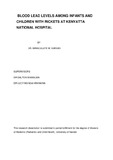| dc.description.abstract | Background & objectives:
Modem environmental health hazards including lead are becoming a public health issue of increasing concern. Lead, a toxic heavy metal accounts for 0.6 % of the global burden of disease. Centre for Disease Control (CDC) defines elevated blood,lead levels as those above 1 O~g/d\. This is a public health action level, not a toxicity threshold since there are no safe blood lead levels.
In Kenya, elevated blood lead levels have- been found in significant proportions in both children and adults. Lead is known to interact with the metabolism of calcium and vitamin 0 at various levels in the body and lead toxicity is associated with low levels of both calcium and Vitamin 0, the main causes of rickets in our set up. This study primarily aimed to determine the blood lead levels in infants and children with rickets and compare these to the levels of an age matched
comparative group without rickets.
Methodology:
This was a hospital based descriptive cross sectional study with a comparative arm carried out at the Kenyatta National Hospital over a period of three months. Infants and children aged 3 months to 3 years who fit the case definition of rickets, and an age matched comparative group without rickets were recruited. A questionnaire was administered and a venous blood sample drawn to determine blood lead levels.
Results:
A total of 100 cases were identified, 50 with rickets and 50 without rickets. THe mean age was 9.7 months with 78% being infants. A male preponderance (68%) was noted among the children with rickets. Two percent of the cases with rickets had elevated lead levels compared to 0% in the comparative arm.
The mean lead level was 2.2ug/dl in the rickets group and 2.5~g/dl in the comparative group. Having a diagnosis of rickets was not associated with elevated lead levels (p=1.000). However, low level lead exposure (~2~g/dl),wasnotei in 68% of those with rickets and in 82% of the comparative group. comparative group was 0%. None of the child or socio-demographic factors investigated was found to be associated with elevated lead levels 2:1 0IJg/dl.
Conclusion:
The prevalence of elevated lead levels in children with rickets was 2% while that in the Elevated lead levels were not found to be associated with rickets in this study. low levels of blood lead below CPCIWHO defined public health action threshold were found with 71 % of the infants and children sampled having levels above 2:2ug/dl.
Recommendation:
Due to the serious adverse effects associated with lead toxicity even at low levels, this study justifies reinforcement of preventive measures and public health education to mitigate the effects of lead toxicity. | en_US |

